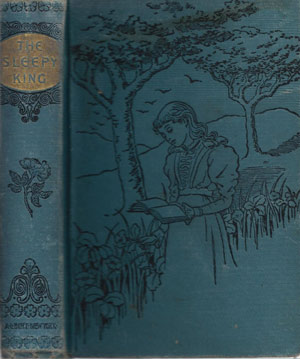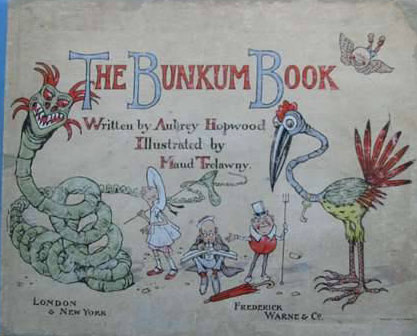Aubrey Hopwood 1863-1917
Aubrey Hopwood was involved with the famous names of the Edwardian musical comedy craze and also wrote nonsense books for children. Known as an adult as Aubrey, Henry Aubrey Hopwood was the second son of John Turner Hopwood of Blackburn in Lancashire and his wife Mary Augusta Henrietta (née Coventry). He was born in Charlotte Square, Edinburgh while his father was still MP for Clitheroe in Lancashire. His father's money came from the cotton trade and his mother's Coventry and Dundas connections linked him distantly to the peerage. One of nine children Aubrey was educated at Cheam School and at Charterhouse. His father kept a house at Rutland Gate in Kensington, London and later bought Ketton Hall in Rutland where he moved in a large musical organ. The family seem to have had a strong interest in music and in poetry with a younger brother, Ronald, finding fame in 1916 with poems with a naval theme including The Laws of the Navy.
 Aubrey was briefly a Lieutenant in the Northamptonshire Regiment. In 1884 he went to America with his older brother, heading to Orange County, Florida via New York. Later, in 1897, he wrote Down by the Suwanee River. A tale of adventure and romance, among the orange plantations of Florida, it might form a film script today.
Aubrey was briefly a Lieutenant in the Northamptonshire Regiment. In 1884 he went to America with his older brother, heading to Orange County, Florida via New York. Later, in 1897, he wrote Down by the Suwanee River. A tale of adventure and romance, among the orange plantations of Florida, it might form a film script today.
In 1886 and 1888 he again travelled to America via New York, one biography said he travelled the world but so far no evidence for this has been found. He did start to write books for children from 1898 while also writing humorous lyrics which contributed to the musical comedy craze of 1897 to 1903. At the same time between 1893 and 1907 he was the Secretary of Arthur's Club, in St. James, London, in a building with a classical façade designed in 1825. It was described thus 'Arthur's has always been something of a country gentleman's club, and preserves many characteristics of those earlier days when, according to Mr Ralph Neville, "sheep points and bullocks on the rubber" was a not uncommon form of betting'. E Beresford Chancellor (1922) Memorials of St James's Street, London (St Martin's Street), Grant Richards Ltd.
Aubrey moved in theatrical and musical circles as a lyricist for several popular musicals and musical plays, which were promoted by or starred the increasingly famous actor Seymour Hicks and his wife Ellaline Terris, such as The Circus Girl which opened at The Gaiety in 1896 with The Prince of Wales at the first night. It played in New York returning to London's famous Gaiety Theatre in 1897. During its run Ellaine's father, the actor and theatre manager William Terris, was murdered by a disaffected actor. The Runaway Girl followed in May 1898 with Ellaline in the main part. The Globe commented 'Messrs Hopwood and Greenbank have written some very amusing and a few graceful verses, and Messrs Ivan Caryl [sic] and Lionel Monckton have endowed those verses with a highly skilful and effective setting.' It ran for 593 performances in London, closing in 1900, and for 216 performances in New York.
In 1898 Aubrey Hopwood's and Seymour Hicks' new Christmas book for children was published: The Sleepy King, described as a fairy tale with seventy-seven illustrations by Maud Trelawney. One reviewer in The Times said it was 'closely modelled on Alice in Wonderland, [and] is a clever and pretty imitation.' While the St. James Gazette said 'The story is brimful of excellent fun, such as is bound to appeal to the hearts of children to whom the odd sayings and quaint antics of Blob and Blib, the extraordinary twins, should prove an inexhaustible source of mirth.' The Sleepy King was to appear in a theatrical guise in 1901; it was obviously already in their minds as the dedication to Ellaline Terris says 'In the hope that she may one day introduce bluebell to the stage, where Cinderella made so many friends.' The heroine is a poor orphan girl carrying a basket of violets and matches which she is trying to sell to help provide a Christmas dinner for her and her young sister. A kind gentleman gives her enough for the meal and after it she reads a fairy story about The Sleepy King and they fall asleep, Bluebell dreaming at length of this odd land. On waking the kind gentleman returns to adopt the children.
There were close links between George Edwardes, manager of the Gaiety Theatre and Richard D'Oyly Carte for whom he had worked at the Opera Comique Theatre, near The Gaiety, and when Carte built the Savoy Theatre. Clifton Coles suggests The Lucky Star which opened in January 1899 was 'the plainest attempt to capitalise on the success of musical comedy' by D'Oyly Carte at The Savoy. This was to be a vehicle for the vocal, comedic and acrobatic talents of Walter Passmore as King Ouf. Aubrey Hopwood was brought in to work on four additional colloquial English lyrics and another two adapted from the American version (The Merry Monarch) of L'Etoile by Emanuel Chabrier. The complicated libretto involved six other people as well as Helen D'Oyly Carte (under her other name of Helen Lenoir). Coles said the 'lyrics were typical of musicals in that they generally interrupted the action, were sometimes extremely silly and other times unimaginative, and were designed to exact a tune from Caryll.' The topical songs included allusions to the looming Boer War. There were various adjustments to libretto, music and cast but it only ran for 143 performances closing in to May 1899. The Savoy then focused on comic opera.
The Merry Go-Round was a musical farce (an up-to-date musical play) in two acts by Seymour Hicks with lyrics by Aubrey Hopwood and music by W. Meyer Lutz, the resident composer at The Gaiety, with several additional songs by others, including Ellaline Terris. It was produced that same year by George Edwardes and toured around English theatres between April and June.
In 1900 Aubrey published another children's book The Bunkum Book, again with illustrations by Maud Trelawney. A quirky story in verse of a topsy-turvey land which owes something to Edward Lear. Wise Goggles, owner of The Bunkum Book, the Gaby of limited intellect and the bold Puffy, set sail in a red umbrella where on a distant shore they meet Wood Violet, White Rose and Ylang-Ylang who is Japanese. The illustrations of these three maidens are reminiscent of the buxom Gaiety Girls, they also draw to mind The Geisha and The Mikado. On a pink giraffe the characters all head for the Land of Lollipops and the Sugar Mountains, facing up to various beasts to capture the Weasel and take it home. This is a story that might be turned into a film through CGI but when written would have been impossible to stage.

In late 1900 Ellaline Terriss played the title role in Alice in Wonderland for a production at The Vaudeville Theatre. Aubrey wrote lyrics to additional music by Walter Slaughter for such as Rabbit Song and Poor Mad Hatter Duet.
The biggest hit, Bluebell in Fairyland (later called just Bluebell when in 1905 it was revived), was first performed for the Christmas season in 1901, a musical dream-play by Seymour Hicks with music by Walter Slaughter with lyrics by Aubrey Hopwood and Charles H. Taylor. The cast, headed by Ellaline Terris in the title role and Hicks as the Sleeping King, included other famous names of the time such as Phyllis Dare and in 1905 Sydney Fairbrother. It first ran for 294 performances ending 26 June 1902. Ellaline Terris in her book Just a Little Bit of String (1955) published by Hutchinson, with its title taken from her hit song in The Circus Girl wrote
"And the lesson learnt from the production of Alice was to inspire us to produce one of the biggest successes of our lives - Bluebell in Fairyland. It was produced at the Vaudeville in the December of 1901. It was an enormous success. Designed simply as a Christmas entertainment, it ran on and on. We played it twice daily for several months and then did nine shows a week. I had to be on stage for almost the whole of the performance and had a very trying time. But it was a joy to play it, all the same. This beautiful story of London - and the Strand and Drury Lane and then Dreamland or Fairyland, whichever you choose to make it."
According to Ganzl K. (1994) in The British Musical Theatre it was revived in 1916, again with both Hicks and Terris reprising the parts of Dicky and Bluebell, for a further 100 performances. It went on tour and was also intermittently produced for the Christmas season in London between 1917 and 1937 living on well beyond Aubrey's life but not Ellaline (by then Lady Hicks) as she did not die until June 1971, aged 100.
n April 1901 they tried You and I, a musical farce in one act by Seymour Hicks with lyrics by Aubrey Hopwood and music by Walter Slaughter, in tandem with Sweet and Twenty. It was set in the kitchen of a Highland Shooting Lodge and revived in a triple bill in 1907. Aubrey and his parents had stayed in Scotland on shooting holidays when he was a lad.
In 1903 Aubrey published Rhymes without Reason. The Cherry Girl a musical play in two acts by Seymour Hicks with lyrics by Aubrey Hopwood to music by Ivan Caryll was produced at the Vaudeville Theatre for the Christmas season that year and ran for 215 performances, closing in June 1904. Again the cast included Seymour Hicks and Ellaline Terris. It was notable for the plaster model by Albert Toft of Ellaline in the title role which stood in the vestibule of the theatre.
A different style of book followed in 1905 with The Old English Sheepdog: from Puppyhood to Championship, a handbook for beginners. It seems that Aubrey, who remained single, considered himself either an author (1901 census), or a private secretary (1911 census) when his sister Mrs Ramsay, niece of the Dowager Countess of Suffolk was staying with him in Malmsbury. She later rented a house in Malmsbury and Aubrey stayed with her until just before his death aged 54 of tuberculosis and GPI. The house is coincidentally now home to a well known musician involved in musicals.
The George Edwardes Musical Comedy Society is to hold a read-through and sing-along of A Runaway Girl in London, in September 2011.On the internet are old recordings and sheet music of Aubrey's hit songs, plus many newspaper and magazine photographs of the casts and actresses. The internet may confuse with inaccurate links to the firm of Hopwood and Ascherman, the music publishers for which there is no evidence and the American playwright Aubrey Hopwood. Teasing out the real story is on ongoing project.
Stella and Rose's Books would like to express their thanks to Denise Le Voir for her hard work in gathering the information for this article and for her kind permission in allowing us to publish it.
Based on reviews including those in The Era, programmes in the Victoria and Albert Theatre Museum collection, the Gilbert and Sullivan Archive available on-line and Hyman H (1975) The Gaiety Years, Cassell.
(Published on 30th Sep 2013 )

